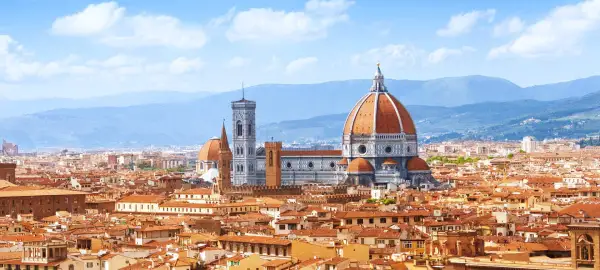Small Group Experiential Travel
Tour Code
IT3
Start
Palermo (PMO)
End
Florence (FLR)
Tour type
Cultural
Max Group Size
18
When To Go
May, Sep
Activity Level
2 - Moderate
Overnight in
Rome, Palermo, Florence, Siracusa, Siena, Lerici, Agrigento, Paestum, Taormina
- Overview
- Info & Inclusions
- Itinerary
- Map & Hotels
- Photos
- Dates & Prices
Highlights
- Guided tours of all major towns and cities visited
- Ancient Greek Temples at Agrigento and Paestum
- Compelling Pompeii
- Rome - The Vatican & the Sistine Chapel
- The Accademia & Michelangelo's David
Price Includes
- Full-time Tour Leader service plus local guides at some locales.
- Breakfast and dinner (mostly local restaurants) daily.
- All sightseeing and entrance fees for sites noted as 'visited' in the detailed itinerary.
- Gratuities for local guides, drivers, restaurant staff, porters.
- Airport transfers for land & air customers and for early arriving/late departing land & air customers who also book their extra hotel nights through us.
Exclusions
- International airfare to/from the tour.
- Tour Leader gratuities, lunches, drinks, personal items (phone, laundry, etc), air taxes (if applicable), and excursions referenced as 'optional'.
- Airport transfers for Land Only customers.
- Optional travel insurance. Click on the “Resources” tab for more information
Trip Info
- Seasonality and Weather:
If you’re a fan of milder weather and less-crowded travel experiences, either spring or fall is the perfect times to plan your Italian adventure. Italy is fortunate to have a temperate climate most of the year, with the summer months (June, July, and August) being the hottest.
SOUTH - SPRING
The weather in Sicily in May is characterized by an abundance of sunshine and gentle breezes, offering an average of 10-11 hours of daylight for exploration. As the average temperature in Sicily in May is about 18C, this month encapsulates the allure of Sicily in spring.
FALL
In Campania and Sicily, fall weather remains comfortably warm, with daytime temperatures ranging from 20-25C (68-77°F) and cooler evenings at around 14-18C (57-64°F). The coastal regions, such as the Amalfi Coast and Naples, offer an enjoyable seaside experience with temperatures ranging from 18-23C (64-73°F) during the day and around 12-17C (54-63°F) in the evenings.
NORTH - SPRING
Italy's weather in May is exceptionally welcoming, with mild temperatures and conditions made for blooming flowers. Travel is very comfortable, as you'll avoid the blistering heat typical of summer. As summer approaches, temperatures in most parts of Italy start to rise. In central and northern Italy, including cities like Florence and Venice, May temperatures typically range from mild to warm, with average highs between 15C (59°F) and 23C (73°F).
FALL
With its vibrant fall colours and bountiful harvest, October is a fantastic time to explore Italy’s stunning landscapes, soak up its rich history, and indulge in mouthwatering cuisine. The summer heat gradually gives way to cooler autumn breezes, creating an ideal atmosphere for outdoor activities. The northern regions experience the early signs of autumn, with temperatures ranging from 12-18C (54-64°F). - Transport and Travel Conditions:
Transport throughout by private air-conditioned motor coach, 24-36 seats depending on ultimate group size (see 'group size'). Though we will have some full bus days, road travel is not particularly arduous as there are plenty of stops of interest and beautiful scenery along the way. Road are in good condition, though a little winding on some stretches. Short daytime ferry crossing. Walking tours on cobbled surfaces.
Am I suitable for this tour? Please refer to our self-assessment form - Accommodation:
Well-located, air-conditioned, mid-range hotels and inns (3-star) used throughout. Some hotels are smaller properties (3-4 story) that may not have elevators. All hotels have en suite bath, though some may have shower only. Porter service is sometimes available (see 'inclusions') though you should be independent with your luggage. Single rooms are limited and likely smaller than twins. - Activity Level: 2
These are particularly busy tours that feature a lot of moving around, sometimes by train and short journeys on local transport. Walking tours of towns and cities are leisurely but you should be prepared to be on your feet for several hours. Some of our cultural trips that occur at high altitude and/or require greater independence with baggage handling (at hotels, airports, train stations) also fall into this category.
To learn more about the Activity levels, please visit our tour styles page. - Staff and Support:
Tour Leader throughout, driver(s), local step-on guides in various locales. - Group Size:
Maximum 18 plus Tour Leader
Download Itinerary
- Day 1:Arrive in PalermoToday we arrive in Palermo and transfer to our hotel.
Palermo is the capital of both the autonomous region of Sicily and the Metropolitan City of Palermo. The city is noted for its history, culture, architecture and gastronomy, playing an important role throughout much of its existence; it is over 2,700 years old. To gain an initial understanding of the city's unique culture, start by wandering the streets of the old city. The mix of architectural styles points to the wave upon wave of invaders who have claimed the city as their own, as does the look of the locals.
Overnight in Palermo.
Included Meal(s): Dinner - Day 2:Palermo: City TourWe begin our day with a walk through the narrow streets of the Il Capo outdoor market. Here we feel the very pulse of the city's daily life, passing stalls where fishmongers display whole sword fish and tuna, and several varieties of squid and octopus. Sicily is agriculturally rich and here some of the island's excellent produce is displayed: apples from the slopes of Mount Etna; oranges and lemons, introduced to Sicily by the Arabs; cactus pears, fresh figs and grapes, fat olives, fresh capers, zucchini blossoms, fresh ricotta and pungent pecorino cheese.
A short walk brings us to the Piazza Praetoria with its voluptuous 16th century Florentine fountain, decked with renaissance nudes and animal heads. At its unveiling, centuries ago, locales named it "the fountain of shame". Nearby is the baroque Quattro Canti, the 17th century crossroads that divides the old city into four, and the Municipio, a 15th century palazzo that is Palermo's city hall.
On the Piazza Bellini, we step inside the Martorana Church; a 12th century building that is a jewel of Arab-Norman architecture, and its interior encrusted with byzantine mosaics. And no visit to Sicily would be complete without a stop at Monreale, the Royal Mountain. It was here, at the end of the 12th century, that the Norman king, William II had a great cathedral built to reflect the sophistication and wealth of his kingdom.
We finish our day at the superlative Church and Monastery of Santa Caterina d'Alessandria, built as a hospice in the early 14th century and transformed into a Dominican convent the following century. This monastic complex wows with its magnificent maiolica cloister, surrounded by unique balconied cells and punctuated by an 18th-century fountain by Sicilian sculptor Ignazio Marabitti. The convent's rooftop terraces offer spectacular views of the surrounding piazzas and city, while the church's baroque interior harbours works by prolific artists. While the last nuns moved out in 2014, their tradition of baking lives on at the convent's onsite bakery I Segreti del Chiostro, which specialises in the traditional sweets made for centuries in Sicilian convents. As this is a large site, we end today's formal tour here so you can choose to linger and explore on your own before gathering for dinner this evening.
Overnight in Palermo.
Included Meal(s): Breakfast and Dinner - Day 3:Palermo - Segesta - Selinunte - AgrigentoToday our route to Agrigento takes us first to Segesta to see the picturesque Doric temple. Sicily was part of ancient Magna Graecia. In the 8th century BC, with population rising dramatically in mainland Greece, land became expensive and resources scarce. This led to an exodus of Greeks in search of new lands. Sicily and southern Italy were to Ancient Greece what the Americas were to 16th century European explorers: the great unknown; a land of possibilities, riches and great dangers. Segesta was a successful colony, which fought with its rival Selinunte to the south, our next stop.
After a break for lunch, we visit the the ruins of Selinunte, some of the most impressive of the ancient Greek world and one of the most captivating sites in Sicily. Selinos (as it was known to the Greeks) was once one of the richest and most powerful cities in the world, with over 100,000 inhabitants and an unrivalled temple-building program. The city was forgotten until the middle of the 16th century, when a Dominican monk identified its location. Excavations began in 1823, courtesy of two English archaeologists.
We continue to Agrigento for dinner and overnight.
Overnight in Agrigento.
Included Meal(s): Breakfast and Dinner - Day 4:Agrigento: Site Tour - Piazza Armerina - EnnaThis morning we tour the magnificent series of temples of Agrigento. The five elevated temples are a picture-perfect tribute to the indomitably of paganism. Time, earthquakes, vicious Punic Wars, and the rise of Christianity have taken their toll, and the temples have been named official World Heritage landmarks.
Then, leaving behind the ancient Greek world behind, we drive inland across the island where, near the town of Piazza Armerina, we explore the remarkable ruins of a Roman villa. Built at the end of the 4th century AD, this vast complex which includes extensive baths, reception rooms, and private apartments may have been an imperial villa of Diocletian's co-emperor, Maximianus. The villa contains some of the most beautiful and extensive Roman mosaics to be found anywhere, including detailed and colourful hunting scenes, images from mythology, and a charming sequence of bikini-clad ladies doing aerobics!
We continue to Enna where you will have some free time to explore the town. See the Castello di Lombardia or Torre di Federico II for stunning views; your Tour Leader will point you in the right direction.
Overnight in Enna.
Included Meal(s): Breakfast and Dinner - Day 5:Enna - Siracusa: Archaeological ParkToday we drive toward the eastern side of the island, coming within sight of the slopes of Mount Etna. At 3313 m (10,866 feet), Etna is one of the earth's most active volcanoes -- both a blessing and a curse for the local people. The surrounding lands are extremely fertile, but there looms the constant possibility of an eruption. The nearby city of Catania was almost completely buried by lava flows in 1669.
We arrive at Siracusa (Syracuse) and tour of the Archaeological Park, including the Greek theatre, Monumental Altar of Hieron II, and the Latomia del Paradiso (quarry with the Ear of Dionysius). After a break for lunch we have a walking tour of Ortygia (old Siracusa), wandering the narrow streets of the old city where we see the Temple of Apollo, Fountain of Aretusa, the main piazza, and the Duomo, a former Temple of Athena.
Overnight in Siracusa.
Included Meal(s): Breakfast and Dinner - Day 6:Siracusa - Mount Etna - TaorminaWe depart Siracusa and drive up the east coast to Taoromina, with stunning views of Mount Etna. We'll make a detour and drive up the side of Etna -- have a sweater handy as we'll be approaching 1800m / 6,000 ft! (depending on weather, we may explore Mount Etna tomorrow instead). This is the highest volcano in Europe and one of most active of the world; its spectacular eruptions and its fiery lava flows have always aroused the interest of scientists, along with the curiosity of visitors from all over the world.
We continue to Taormina, arguably the most beautiful town in Sicily, an old hilltop town full of history and culture and by the sea. Taormina is also famous for incredible heritage in history, archaeology and architecture, as well as for its reputation in welcoming travellers.
Overnight in Taormina.
Included Meal(s): Breakfast and Dinner - Day 7:Taormina: City TouringToday we'll have a leisurely walking tour of the town, starting with the almost perfectly-preserved Greco-Roman amphitheatre, Taormina's greatest treasure. In ancient days, the 3rd-century cliff-side arena seated 5,000 spectators, with Mount Etna framed perfectly as a backdrop to the 1,800 year old stage.
We see also the Palazzo Corvaia with its blend of Arab, Norman, and Catalan elements where, in 1410, Sicily's first parliament was convened. The Corso Umberto I is a charming pedestrian street that runs the length of town. There are many shops and boutiques along the way and at the Piazza IX Aprile, there are lovely views of Naxos harbour and the Italian mainland across the straits. Perched on a peak above the town is the medieval fortress. In the Piazza del Duomo where Taormina's 15th century basilica/cathedral stands, there is a fountain topped by the symbol of the town: the statue of a female centaur.
The afternoon is yours for independent exploration.
Overnight in Taormina.
Included Meal(s): Breakfast and Dinner - Day 8:Taormina, Sicily - Paestum, Italian MainlandThis morning we take a short ferry ride from Sicily to the Italian mainland and then proceed by motor coach to Paestum.
The three Doric Greek temples of Paestum are among the best preserved in the world, even rivaling those of Sicily and Athens. Originally built without any mortar or cement (they were simply covered by roofs of terra-cotta tiles supported by wooden beams) the temples remained standing even after the great earthquake of AD 69 reduced Pompeii's streets to a pile of rubble. After a period of native Italian control in the 5th and 4th centuries BC, it fell to the Romans in 273 BC and was renamed Paestum, remaining a Roman town until the deforestation of nearby hills turned the town into a swampy mush. Plagued by malaria and syphilitic pirates, Paestum's ruins lay relatively untouched until they were rediscovered in the 18th century.
Overnight in Paestum.
Included Meal(s): Breakfast and Dinner - Day 9:Paestum - National Archaeological Museum - PompeiiToday we travel to Naples where we see the colourful harbour front and the Castel dell'Ovo, a 12th-century fortress built on the ruins of an ancient villa, before our visit to the National Archaeological Museum. This impressive facility houses one of the world's most comprehensive collections of Greek and Roman antiquities. The museum stands on top of Santa Teresa Hill and was originally built as a military barrack later transformed into a university campus. It was remodeled in 1790 to receive the treasures of Pompeii and Herculaneum.
Our next stop is the ancient site of Pompeii. Dug out from the inundation of volcanic ash and pumice stone that covered it by the eruption of Mount Vesuvius in AD 79, the entire area is a fantastic record of how ordinary Romans lived their lives. We will see the House of Vetti, the most elegant of the Pompeii villas and we also look at the House of Mysteries. The nearby House of Faun takes up a city block and has four different dining parlours and two spacious gardens.
Overnight in Pompeii.
Included Meal(s): Breakfast and Dinner - Day 10:Pompeii: Herculaneum & the Amalfi CoastThis morning we visit Herculaneum, a small town that was buried under Vesuvius's lava. Our tour here will include the baths, which were built during the reign of Agustus. An outstanding example of how the aristocracy lived is provided at the Casa dei Cervi.
We then drive along the famous Amalfi Coast on a winding road carved out of the rock in the mid-19th century. This scenic and unforgettable drive takes us to Amalfi, a resort town on the peninsula of the same name where we take a walking tour of the city. We will see the beautiful Duomo cathedral with its 13th century bell tower, the main square of the town, and the Cloister of Paradise.
After a break for lunch and some free time in Amalfi, we take the ferry to the port of Salerno where our bus will be waiting. This is a great way to truly experience the spectacular coastline with this relaxing journey (calm weather-permitting!).
On arrival in Salerno we'll rejoin our bus and return to our Pompeii hotel.
Overnight in Pompeii.
Included Meal(s): Breakfast and Dinner - Day 11:Pompeii - Monte Cassino - RomeToday's journey takes us to north to Rome via Monte Cassino. During the Roman Empire, the abbey located here was one of the great European centres of Christendom and one of the largest repositories of ancient learning. In 1944, Monte Cassino was destroyed by the Allied forces who suspected that it was occupied by German troops. The military cemetery on the nearby hill contains the graves of 1,100 Polish soldiers who lost their lives in the final assault.
Later we continue to Rome.
Overnight in Rome.
Included Meal(s): Breakfast and Dinner - Day 12:Rome: City TourWe begin our guided tour* of Rome at the 2,000 year old colosseum. Built to seat 55,000 spectators, this arena staged Rome's most brutal gladitorial combats. Next we walk through the Roman Forum where we will see the Curia, the Rostra, the Temple of Vesta, the Basilica of Constantine, and the Arch of Titus. Continuing onwards and upwards we reach the Campidoglio (Capitoline Hill), seat of the Roman Senate since the 12th century and the original citadel of the city. This beautiful square was redesigned by Michelangelo in the 16th century.
We arrive at Piazza Navona where we can break for lunch at one of the many restaurants and cafes on or near the square. In the square itself we can admire the impressive Fountain of the Four Rivers, with detailed figures representing the Nile, Ganges, Danube and Palata rivers.
We continue to the famous Trevi Fountain, designed by Nicholas Salvi in 1732. Its water was supplied by one of Rome's earliest aqueducts. Throwing a coin into the fountain is said to ensure your safe return to Rome. We also visit the temple-turned church called the Pantheon, and have the opportunity to admire its perfect proportions on our way to the Spanish steps, where we finish our day's tour.
* NOTE: Due to traffic problems and the fact that today's sites are reasonably close to each other, much of today's tour will occur on foot and with Rome's efficient public transit system (cost of tickets included). Any sightseeing / touring not accomplished today will be moved to tomorrow afternoon.
Overnight in Rome.
Included Meal(s): Breakfast and Dinner - Day 13:Rome: the Vatican Museums & St. Peter'sToday we travel by metro to the west side of the Tiber River and begin our visit to Vatican City with a guided tour through the immense Vatican Museums.* This amazing collection houses some of the most important Greek and Roman sculptures, Renaissance paintings, Flemish tapestries and mosaics in the world. Understandably this collection is visited by more than 3 million people a year. We also visit Michelangelo's Sistine Chapel to take in its breathtaking frescoes.
Heading into the cavernous interior of St. Peter's Basilica, we can appreciate it's many treasures, including Michelangelo's Pieta. At the end of the Vatican tour we visit the elegantly symmetrical Piazza St. Pietro.
After a break for lunch we will continue with any sightseeing carried over from yesterday.
* NOTE: The timing/order of today's sightseeing can vary depending on seasonality. Early spring and late fall tours can often begin in the morning due to lighter crowds at these times of year. Busier times often dictate an afternoon/evening visit in order to avoid morning crowds; indeed, we may include lunch instead of dinner today in order to expedite the flow of our activities. Your Tour Leader will advise of any adjustments upon your arrival in Rome.
Overnight in Rome.
Included Meal(s): Breakfast and Dinner - Day 14:Rome - Assisi - SienaThis morning we drive from Rome to Siena, a region famous for its wines.
Our first stop will be Assisi. Despite the millions of tourists and pilgrims it attracts every year, the hometown of St Francis remains a beautiful and tranquil refuge. St Francis was born here in 1182 and his spirit hovers over every aspect of the city's life. He renounced his father's wealth in his late teens to pursue a life of chastity and poverty, founding the order of mendicant friars known as the Order of Minors (the Franciscans after his death) which attracted a huge following in Europe.
St Francis' Basilica is the city's, and possibly Umbria's, primary attraction; after a guided tour of the basilica we depart for Siena, arriving later in the afternoon.
Overnight in Siena.
Included Meal(s): Breakfast and Dinner - Day 15:Siena & San GimignanoSiena is best seen on foot. In fact, the city council was Europe's first to ban motor traffic from the city centre. Siena today seems frozen in time -- the town has traditionally been Florence's rival as the centre of art and architecture in Tuscany. While Florence is known for its Renaissance art and buildings, Siena takes us straight back to the Middle Ages. Perhaps by preserving its original character more than any other city in Italy, Siena is a showcase of the Italian Gothic style. The walled city of Siena occupies three hill tops and contains a rich artistic heritage.
Included on our guided walking tour of Siena's charming medieval streets and squares is a visit to the Palazzo Pubblico (Town Hall), a famous example of Italian medieval architecture with Gothic influences. Also famous for its frescoes, the best-known are a secular series on government in the Hall of the Nine (also known as Sala della Pace), by Ambrogio Lorenzetti. These frescoes are collectively known as "Allegory and Effects of Good and Bad Government."
Our next stop is the Duomo. This huge cathedral, built in bands of black and white marble, dates from the 12th century. Built in the Romanesque and Italian Gothic styles, it has a dramatically painted façade -- partly designed by Giovanni Pisano -- and a soaring black and white bell tower. The inlaid marble floor depicts different Biblical scenes and the cathedral contains a glass-enclosed box with an arm. Tradition maintains that the arm is that of John the Baptist and was used to baptise Christ.
This afternoon we drive to San Gimignano, called the Manhattan of Tuscany. The medieval town preserves 13 of its noble brick towers, which give it a skyscraper skyline. Today its fortress-like severity is softened by the subtlety of its quiet, harmonious squares, and many of its places and churches are enhanced by Renaissance frescoes.
Our drive this afternoon back to Siena takes us through the wine growing region of Chianti.
Overnight in Siena.
Included Meal(s): Breakfast and Dinner - Day 16:Siena - Volterra - Pisa - LericiThis morning we drive through beautiful and quintessential Tuscan rolling countryside to Volterra.
Situated like many Etruscan cities on a high plateau, Volterra offers uninterrupted views over the surrounding hills. In many places the town's ancient Etruscan walls still stand. The exact origins of the Etruscans and when they arrived in Italy, are unknown. Their civilisation was centred in the area between present-day Rome and Florence, and had its Golden Age from the eighth until the sixth century BC. After this period the Etruscan empire was gradually superseded by the rising power of Rome, although in the process, the Romans incorporated many aspects of Etruscan culture into their own society and beliefs. Although the Etruscans had their own language and alphabet, nothing of their literature has survived. What we know of their civilisation comes mainly from their highly decorated tombs which were stocked with everything the deceased would need in the afterlife -- food, drink, clothes, weapons and furniture.
We also visit the city walls and the Etruscan Gate with its basalt heads of Etruscan gods dating back to the sixth century BC. Before leaving Volterra we view the Roman amphitheatre, dating to the first century BC. This is one of the best-preserved Roman theatres in Italy and enough of the original structure has survived to allow an almost complete reconstruction. In your free time here, we suggest Volterra's famous Museo Guarnacci, which contains one of Italy's best collections of Etruscan artifacts. Pride of place in the museum goes to the collection of 600 Etruscan funerary urns, depicting many aspects of Etruscan customs and beliefs.
Our next stop is Pisa, where we will spend most of our time concentrating on the town's principal monuments -- the Duomo, the Baptistery, and the most famous structure in Pisa, the gravity-defying "Leaning Tower." We will take ample time to view and photograph the tower from the outside (to climb the tower requires advance reservations and a considerable amount of time to queue for entry; time constraints make this impractical for our tour).
We continue to Lerici, set dramatically on a beautiful bay on the Ligurian coast.
Overnight in Lerici.
Included Meal(s): Breakfast and Dinner - Day 17:Lerici - Cinque Terre - FlorenceToday we leave behind Lerici and travel (weather depending) by boat along the Ligurian coast to village of Riomaggiore in the Cinque Terre. Here we begin our easy-paced walk between the coastal villages. This spectacular section of the Italian Riviera is considered to rival the Amalfi Coast near Naples for its stunning views and gorgeous sunsets. From Riomaggiore we take an easy half hour walk on the Via D'Amore (lover's Walk) to Manarola. The next section (about 1 hour) takes us to Corniglia.*
Those not wishing to continue with the next two more difficult sections may walk up to Corniglia centre to sample the delightful town with its wonderful panoramic views. It is also possible to take a local train to the nearby town of Vernazza to enjoy this jewel of a village. Those wishing to continue may start on the 2-hour hike to Vernazza. The hills of the rugged coast are covered in vineyards which grow the grapes for the local Morasca, Chiaretto del Faro and Sciacchetra wines.
We continue by train to Monterosso Al Mare, thus named for the red colour of the area. Here we find a large statue carved into the cliffs and a lovely beach.
* PLEASE NOTE: Due to past flooding in the region, our day may need to be adjusted depending on what trails are open or under repair.
Tonight we arrive in Florence.
Overnight in Florence.
Included Meal(s): Breakfast and Dinner - Day 18:Florence: Walking TourFlorence is a city steeped in history and art. Our walking tour today begins with a guided tour of the Accademia, which was Europe's first Academy of drawing and today houses a superb art collection, including Michelangelo's David, probably the most famous statue in the world.
We then proceed to the Cathedral of Santa Maria del Fiore (commonly known as the Duomo), complete with its magnificent red dome. Upon its completion in 1436, the dome was hailed as the greatest architectural achievement of its day, equaling, perhaps even surpassing, the monuments of antiquity. The cupola's diameter is greater than that of St Peter's in Rome and the nave is the third largest in Christendom. Because the most interesting part of the building is the exterior, and because we will see other church interiors that are more ornate and interesting elsewhere (ie Siena), we do not tour the inside. If you'd like to visit on your own, we suggest perhaps visiting tomorrow afternoon in your free time when crowds and line-ups tend to settle down (consult with your Tour Leader for the best current advice).
We continue along the pedestrian mall to the Ponte Vecchio, the oldest bridge in Florence and the only one in the city to survive World War II. The Ponte Vecchio was built in 1345 and used to be lined with butchers' shops which have now been replaced by rows of gold and silver shops on both sides. At the Piazza Santa Croce, we stop to admire the facade of the Franciscan church of the same name. Inside we see the tombs of Michelangelo and Galileo Galilei and chapels covered in frescoes by Giotto.
Balance of the day at leisure.
Overnight in Florence.
Included Meal(s): Breakfast and Dinner - Day 19:Florence: Uffizi GalleryThis morning we visit the Uffizi Gallery, Giorgio Vasari's extraordinary administrative buildings which he designed for Cosimo I Medici in the mid-sixteenth century. The galleries here contain the greatest collection of Italian artworks, including hundreds of paintings by such great artists as Botticelli, Leonardo da Vinci, Raphael, Michelangelo, Titian and Caravaggio. The galleries also contain one of the most famous paintings in the world -- Botticelli's 'Birth of Venus.'
The afternoon is free to take in the atmosphere of this sophisticated city.
Overnight in Florence.
Included Meal(s): Breakfast and Dinner - Day 20:DepartureDeparture from Florence.
BUON VIAGGIO!
Included Meal(s): Breakfast
Regions Visited: Western Europe and The Adriatic
Countries Visited: Italy
Countries Visited: Italy
*The red tour trail on the map does not represent the actual travel path.
The following is a list of sample hotels at some locations included on this tour. The hotels shown here are meant to provide a general sense of the standard of hotel we usually aim for; they are not necessarily confirmed for your chosen departure.
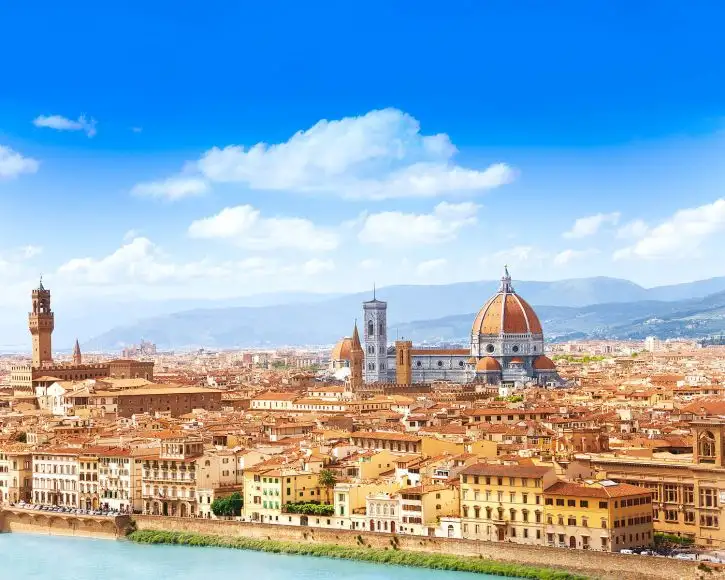
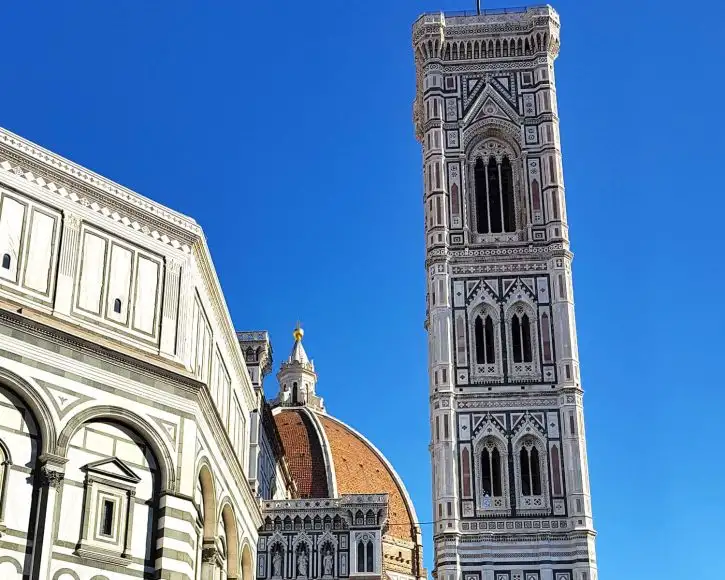
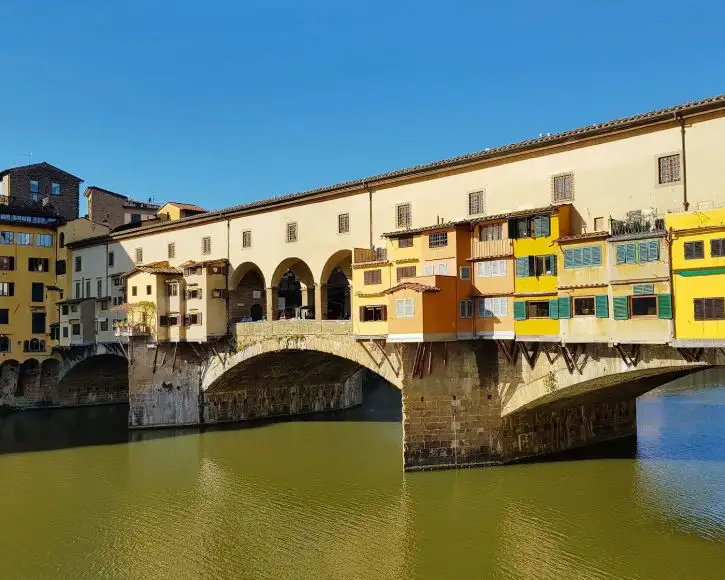
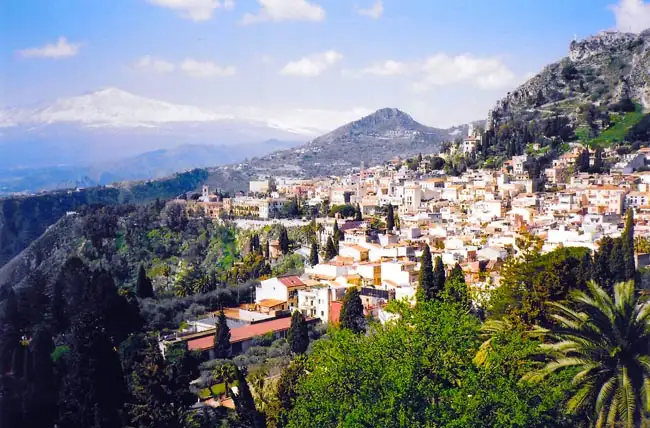
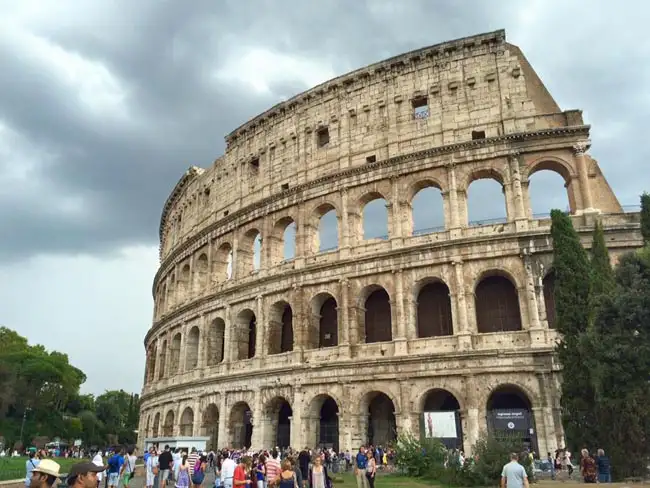
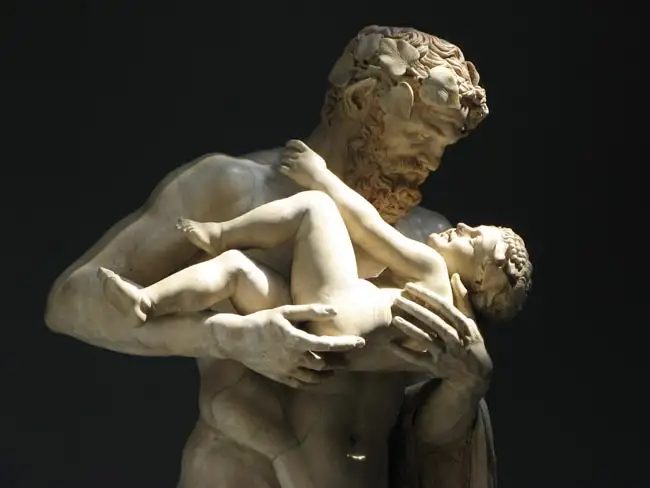
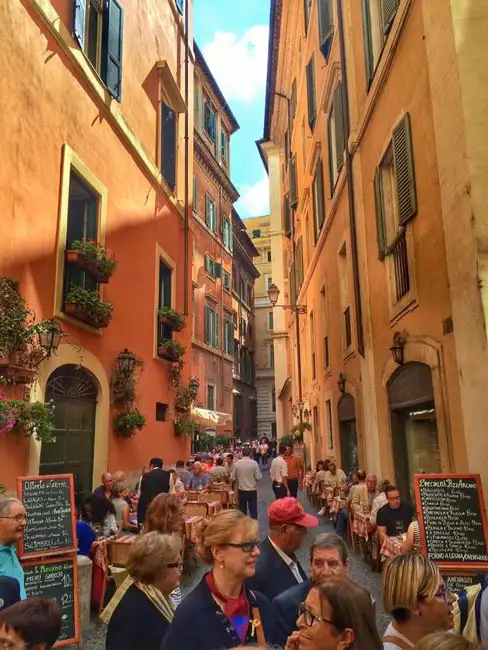
Excellent
Overall Rating
4.6
Extend Your Trip
This tour is part of a series that can be upgraded to make for a longer trip.
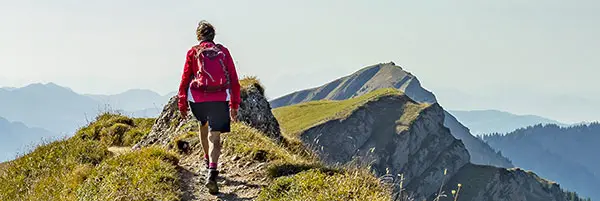
Fast and easy
Book this tour
Book your unforgettable adventure today! For any questions or advice, don't hesitate to contact us.
Have questions?
Contact Us
1-800-665-3998
- Final payment is due 90 days prior to departure.
- A non-refundable $500 USD deposit is payable at the time of booking
- Optional Single Supplement: $1710 USD (number of singles limited).
This tour may require a mandatory single supplement charge of $1280 USD if you join our share program and we are unable to pair you. - Transferring to another tour or tour date is only permissible outside of 120 days prior to departure and is subject to a $100 USD change fee. (Read our cancellation policy for more info.)
Prices below are per person, twin-sharing costs in US Dollars (USD). Pricing does not include airfare to/from the tour and any applicable taxes. Get general information on flights to/from the tour.
Choose your departure date:
Frequently Asked Questions
- What is the maximum number of participants on a trip?Most of our tours carry a maximum of 18 participants; some tours (ie hiking tours) top out at 16. In the event that we do not achieve our minimum complement by our 90-day deadline, we may offer group members the option of paying a "small-group surcharge" as an alternative to cancellation. If all group members agree, we will confirm the trip at existing numbers; this surcharge is refundable in the event that we ultimately achieve our regular minimum. If the small group surcharge is not accepted, we will offer a refund of your deposit or a different trip of your choice.
- Can I extend my tour either at the beginning or end? What about stopovers?Yes, you can extend your tour either at the beginning or the end and we can book accommodation in our tour hotel. Stopovers are often permitted, depending on air routing. Stopovers usually carry a "stopover" fee levied by the airline.
- How do I make a reservation? How and when do I pay?The easiest way to make a reservation is via our website; during office hours, you are also more than welcome to contact us by telephone.
A non-refundable deposit is payable at the time of booking; if a reservation is made within 90 days, full payment is required. Some trips require a larger deposit. If international airline bookings require a non-refundable payment in order to secure space or the lowest available fare, we will require an increase in deposit equal to the cost of the ticket(s).
Early enrolment is always encouraged as group size is limited and some trips require greater preparation time.
Once we have received your deposit, we will confirm your space and send you a confirmation package containing your trip itinerary, any visa/travel permit related documents, invoice, clothing and equipment recommendations, general information on your destination(s), and forms for you to complete, sign and return to us. Your air e-tickets (if applicable), final hotel list, final trip itinerary, and instructions on how to join your tour, will be sent approximately 2-3 weeks prior to departure. - What about cancellations, refunds, and transfers?Please review our cancellation policy page for details.
- I am a single who prefers my own room. What is a single supplement?All of our tours have a single supplement for those who want to be guaranteed their own room at each location.
This supplement is a reflection of the fact that most hotels around the world do not discount the regular twin-share rate for a room by 50% for only one person occupying a room. Most hotels will give a break on the price, but usually in the range of 25-30% of the twin-share rate. This difference, multiplied by each night, amounts to the single supplement.
The conventional amount can also vary from country to country and some destinations are more expensive than others for single occupancy. In order to be "single friendly," the supplements we apply are not a profit centre for us and we do our best to keep them as reasonable as possible.
On most tours we limit the number of singles available, not to be punitive, but rather because many hotels allow for only a limited number of singles; some smaller hotels at remote locations also have a limited number of single rooms available.
Please note that most single rooms around the world are smaller than twin-share rooms and will likely have only one bed. - Do you have a shared accommodation program?Yes! If you are single traveller and are willing to share, we will do our best to pair you with a same-gender roommate. On most of our tours, if we fail to pair you, we will absorb the single supplement fee and you will default to a single room at no extra charge. At some destinations, however, where single rooms are not significantly discounted, or not at all, we may apply a "mandatory" single in the event that we cannot find you a share partner. This is usually 50% of the usual supplement, but can be as much as 100%. If applicable, this proviso will be noted on each tour page on this website, on your invoice, and in our tour date/price book (available for download under "Resources").
Please choose a departure date!
